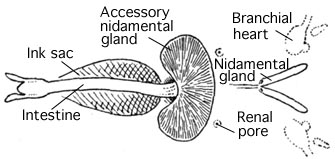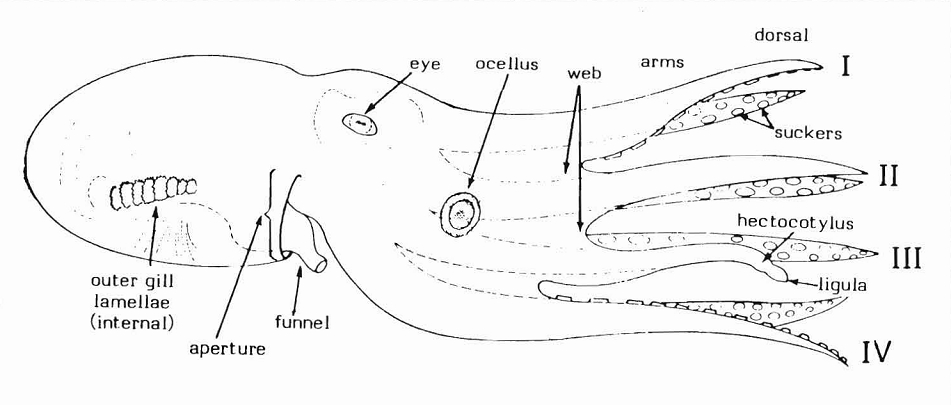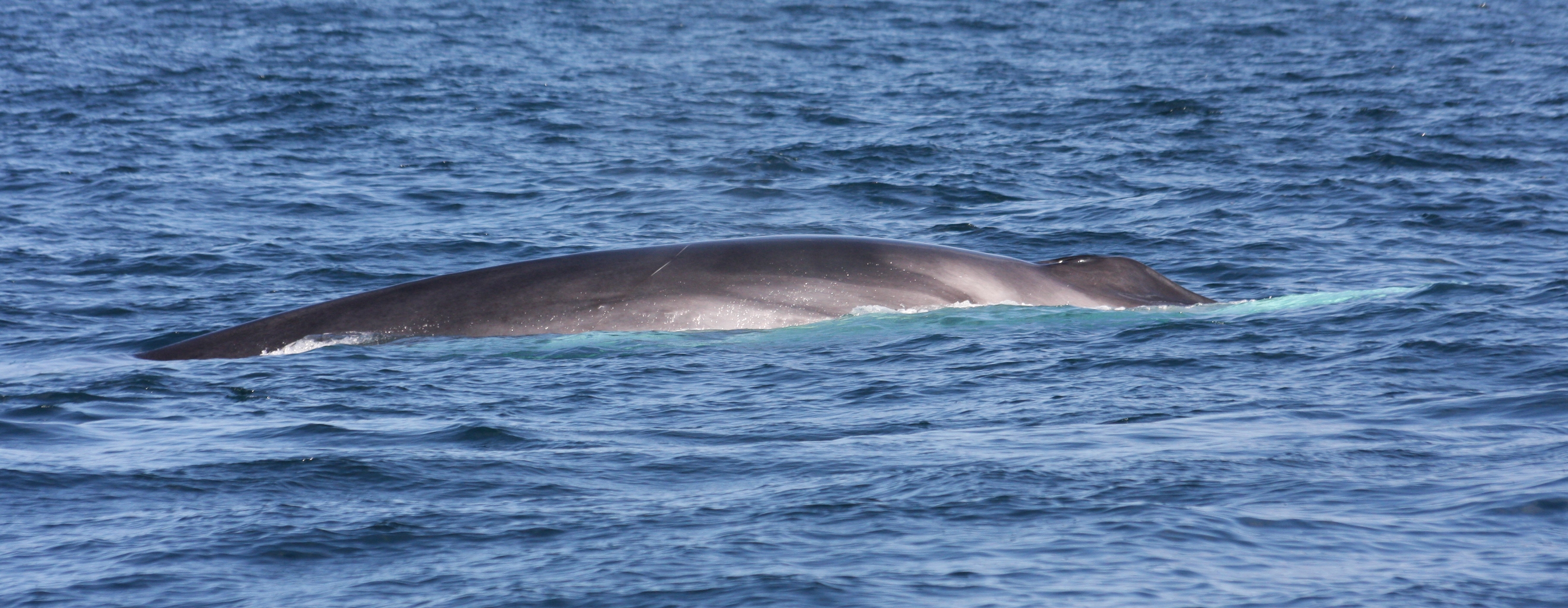|
Cryptoteuthis Brevibracchiata
''Cryptoteuthis brevibracchiata'', the short-arm flapjack octopod, is a deepwater species of octopod. It is the only species in the monotypic genus ''Cryptoteuthis'' one of the cirrate octopuses of the family Opisthoteuthidae, the umbrella octopuses. It is known from a single specimen which was collected in the northeastern Atlantic Ocean. It has characteristics which are shared with two other genera in the Opisthoteuthidae, '' Opisthoteuthis'' and ''Grimpoteuthis'', but is sufficiently distinctive from either of these to warrant the erection of a new genus. Description ''Cryptoteuthis brevibracchiata'' is a bell-shaped octopus with a semi-gelatinous, semi-transparent body, except for the dark tips of the oral web and the tips of the fins. The fins are small and round, and their length is equal to half the width of the head. It has short arms, each with a single row of small, broad suckers and with a double row of cirri which are of moderate length, with each cirrus just longer ... [...More Info...] [...Related Items...] OR: [Wikipedia] [Google] [Baidu] |
Octopus
An octopus ( : octopuses or octopodes, see below for variants) is a soft-bodied, eight- limbed mollusc of the order Octopoda (, ). The order consists of some 300 species and is grouped within the class Cephalopoda with squids, cuttlefish, and nautiloids. Like other cephalopods, an octopus is bilaterally symmetric with two eyes and a beaked mouth at the center point of the eight limbs. The soft body can radically alter its shape, enabling octopuses to squeeze through small gaps. They trail their eight appendages behind them as they swim. The siphon is used both for respiration and for locomotion, by expelling a jet of water. Octopuses have a complex nervous system and excellent sight, and are among the most intelligent and behaviourally diverse of all invertebrates. Octopuses inhabit various regions of the ocean, including coral reefs, pelagic waters, and the seabed; some live in the intertidal zone and others at abyssal depths. Most species grow quickly, mature ea ... [...More Info...] [...Related Items...] OR: [Wikipedia] [Google] [Baidu] |
Ink Sac
An ink sac is an anatomical feature that is found in many cephalopod mollusks used to produce the defensive cephalopod ink. With the exception of nocturnal and very deep water cephalopods, all Coleoidea (squid, octopus and cuttlefish) which dwell in light conditions have an ink sac, which can be used to expel a cloud of dark ink in order to confuse predators. The ink sac is a muscular bag which originated as an extension of the hind gut; it is a modified hypobranchial gland.Nair, J.R., D. Pillai, S.M. Joseph, P. Gomathi, P.V. Senan & P.M. Sherief (2011). ''Indian Journal of Geo-Marine Sciences'' 40(1): 13–27. It lies beneath the gut and opens into the anus, into which its contents – almost pure melanin – can be squirted; its proximity to the base of the funnel means that the ink can be distributed by ejected water as the cephalopod uses its jet propulsion. The ejected cloud of melanin is bound by mucus Mucus ( ) is a slippery aqueous secretion produced by, and c ... [...More Info...] [...Related Items...] OR: [Wikipedia] [Google] [Baidu] |
Monotypic Mollusc Genera
In biology, a monotypic taxon is a taxonomic group ( taxon) that contains only one immediately subordinate taxon. A monotypic species is one that does not include subspecies or smaller, infraspecific taxa. In the case of genera, the term "unispecific" or "monospecific" is sometimes preferred. In botanical nomenclature, a monotypic genus is a genus in the special case where a genus and a single species are simultaneously described. In contrast, an oligotypic taxon contains more than one but only a very few subordinate taxa. Examples Just as the term ''monotypic'' is used to describe a taxon including only one subdivision, the contained taxon can also be referred to as monotypic within the higher-level taxon, e.g. a genus monotypic within a family. Some examples of monotypic groups are: Plants * In the order Amborellales, there is only one family, Amborellaceae and there is only one genus, ''Amborella'', and in this genus there is only one species, namely ''Amborella trichopod ... [...More Info...] [...Related Items...] OR: [Wikipedia] [Google] [Baidu] |
Cephalopod Genera
A cephalopod is any member of the molluscan class Cephalopoda ( Greek plural , ; "head-feet") such as a squid, octopus, cuttlefish, or nautilus. These exclusively marine animals are characterized by bilateral body symmetry, a prominent head, and a set of arms or tentacles ( muscular hydrostats) modified from the primitive molluscan foot. Fishers sometimes call cephalopods "inkfish", referring to their common ability to squirt ink. The study of cephalopods is a branch of malacology known as teuthology. Cephalopods became dominant during the Ordovician period, represented by primitive nautiloids. The class now contains two, only distantly related, extant subclasses: Coleoidea, which includes octopuses, squid, and cuttlefish; and Nautiloidea, represented by '' Nautilus'' and '' Allonautilus''. In the Coleoidea, the molluscan shell has been internalized or is absent, whereas in the Nautiloidea, the external shell remains. About 800 living species of cephalopods have been ... [...More Info...] [...Related Items...] OR: [Wikipedia] [Google] [Baidu] |
Octopuses
An octopus ( : octopuses or octopodes, see below for variants) is a soft-bodied, eight- limbed mollusc of the order Octopoda (, ). The order consists of some 300 species and is grouped within the class Cephalopoda with squids, cuttlefish, and nautiloids. Like other cephalopods, an octopus is bilaterally symmetric with two eyes and a beaked mouth at the center point of the eight limbs. The soft body can radically alter its shape, enabling octopuses to squeeze through small gaps. They trail their eight appendages behind them as they swim. The siphon is used both for respiration and for locomotion, by expelling a jet of water. Octopuses have a complex nervous system and excellent sight, and are among the most intelligent and behaviourally diverse of all invertebrates. Octopuses inhabit various regions of the ocean, including coral reefs, pelagic waters, and the seabed; some live in the intertidal zone and others at abyssal depths. Most species grow quickly, mature early, a ... [...More Info...] [...Related Items...] OR: [Wikipedia] [Google] [Baidu] |
Benthic
The benthic zone is the ecological region at the lowest level of a body of water such as an ocean, lake, or stream, including the sediment surface and some sub-surface layers. The name comes from ancient Greek, βένθος (bénthos), meaning "the depths." Organisms living in this zone are called benthos and include microorganisms (e.g., bacteria and fungi) as well as larger invertebrates, such as crustaceans and polychaetes. Organisms here generally live in close relationship with the substrate and many are permanently attached to the bottom. The benthic boundary layer, which includes the bottom layer of water and the uppermost layer of sediment directly influenced by the overlying water, is an integral part of the benthic zone, as it greatly influences the biological activity that takes place there. Examples of contact soil layers include sand bottoms, rocky outcrops, coral, and bay mud. Description Oceans The benthic region of the ocean begins at the shore line (intertidal ... [...More Info...] [...Related Items...] OR: [Wikipedia] [Google] [Baidu] |
Demersal
The demersal zone is the part of the sea or ocean (or deep lake) consisting of the part of the water column near to (and significantly affected by) the seabed and the benthos. The demersal zone is just above the benthic zone and forms a layer of the larger profundal zone. Being just above the ocean floor, the demersal zone is variable in depth and can be part of the photic zone where light can penetrate, and photosynthetic organisms grow, or the aphotic zone, which begins between depths of roughly and extends to the ocean depths, where no light penetrates. Fish The distinction between demersal species of fish and pelagic species is not always clear cut. The Atlantic cod (''Gadus morhua'') is a typical demersal fish, but can also be found in the open water column, and the Atlantic herring (''Clupea harengus'') is predominantly a pelagic species but forms large aggregations near the seabed when it spawns on banks of gravel. Two types of fish inhabit the demersal zone: those ... [...More Info...] [...Related Items...] OR: [Wikipedia] [Google] [Baidu] |
Ireland
Ireland ( ; ga, Éire ; Ulster Scots dialect, Ulster-Scots: ) is an island in the Atlantic Ocean, North Atlantic Ocean, in Northwestern Europe, north-western Europe. It is separated from Great Britain to its east by the North Channel (Great Britain and Ireland), North Channel, the Irish Sea, and St George's Channel. Ireland is the List of islands of the British Isles, second-largest island of the British Isles, the List of European islands by area, third-largest in Europe, and the List of islands by area, twentieth-largest on Earth. Geopolitically, Ireland is divided between the Republic of Ireland (officially Names of the Irish state, named Ireland), which covers five-sixths of the island, and Northern Ireland, which is part of the United Kingdom. As of 2022, the Irish population analysis, population of the entire island is just over 7 million, with 5.1 million living in the Republic of Ireland and 1.9 million in Northern Ireland, ranking it the List of European islan ... [...More Info...] [...Related Items...] OR: [Wikipedia] [Google] [Baidu] |
Porcupine Seabight
The Porcupine Seabight or Porcupine Basin is a deep-water oceanic basin located on the continental margin in the northeastern portion of the Atlantic Ocean. It can be found in the southwestern offshore portion of Ireland and is part of a series of interconnected basins linked to a failed rift structure associated with the opening of the Northern Atlantic Ocean. The basin extends in a North-South direction and was formed during numerous subsidence and rifting periods between the Late Carboniferous and Late Cretaceous. It is bordered by the * Goban Spur to the south * Slyne Ridge to the north * Porcupine Bank to the west * Porcupine Abyssal Plain to the southwest Due to subsidence, water depths range from 3000 m in the south near its mouth to 400 m in the north. The Porcupine Basin lies on the Caledonian metamorphic basement and preserves up to 12 km of sedimentary strata from Late Palaeozoic to Quaternary which includes significant hydrocarbon reservoirs. Sediment was likely ... [...More Info...] [...Related Items...] OR: [Wikipedia] [Google] [Baidu] |
Species Description
A species description is a formal description of a newly discovered species, usually in the form of a scientific paper. Its purpose is to give a clear description of a new species of organism and explain how it differs from species that have been described previously or are related. In order for species to be validly described, they need to follow guidelines established over time. Zoological naming requires adherence to the ICZN code, plants, the ICN, viruses ICTV, and so on. The species description often contains photographs or other illustrations of type material along with a note on where they are deposited. The publication in which the species is described gives the new species a formal scientific name. Some 1.9 million species have been identified and described, out of some 8.7 million that may actually exist. Millions more have become extinct throughout the existence of life on Earth. Naming process A name of a new species becomes valid (available in zo ... [...More Info...] [...Related Items...] OR: [Wikipedia] [Google] [Baidu] |
Mark Norman (marine Biologist)
Mark Douglas Norman is a marine biologist living in southern Australia, where he works through the University of Melbourne and Museum Victoria. For over a decade, Norman has been working exclusively with cephalopods and he is one of the leading scientists in the field, having discovered over 150 new species of octopuses. The best known of these is probably the mimic octopus The mimic octopus (''Thaumoctopus mimicus'') is a species of octopus from the Indo-Pacific region. Like other octopuses, it uses its chromatophores to disguise itself with its background. However, it is noteworthy for being able to impersonate a .... Mark Norman is the author of ''Cephalopods: A World Guide'', a book published in 2000 containing over 800 colour photographs of cephalopods in their natural habitat. References Australian marine biologists Teuthologists Living people Year of birth missing (living people) {{Biologist-stub ... [...More Info...] [...Related Items...] OR: [Wikipedia] [Google] [Baidu] |
Mantle (mollusc)
The mantle (also known by the Latin word pallium meaning mantle, robe or cloak, adjective pallial) is a significant part of the anatomy of molluscs: it is the dorsal body wall which covers the visceral mass and usually protrudes in the form of flaps well beyond the visceral mass itself. In many species of molluscs the epidermis of the mantle secretes calcium carbonate and conchiolin, and creates a shell. In sea slugs there is a progressive loss of the shell and the mantle becomes the dorsal surface of the animal. The words mantle and pallium both originally meant cloak or cape, see mantle (vesture). This anatomical structure in molluscs often resembles a cloak because in many groups the edges of the mantle, usually referred to as the ''mantle margin'', extend far beyond the main part of the body, forming flaps, double-layered structures which have been adapted for many different uses, including for example, the siphon. Mantle cavity The ''mantle cavity'' is a central fea ... [...More Info...] [...Related Items...] OR: [Wikipedia] [Google] [Baidu] |

.jpg)






